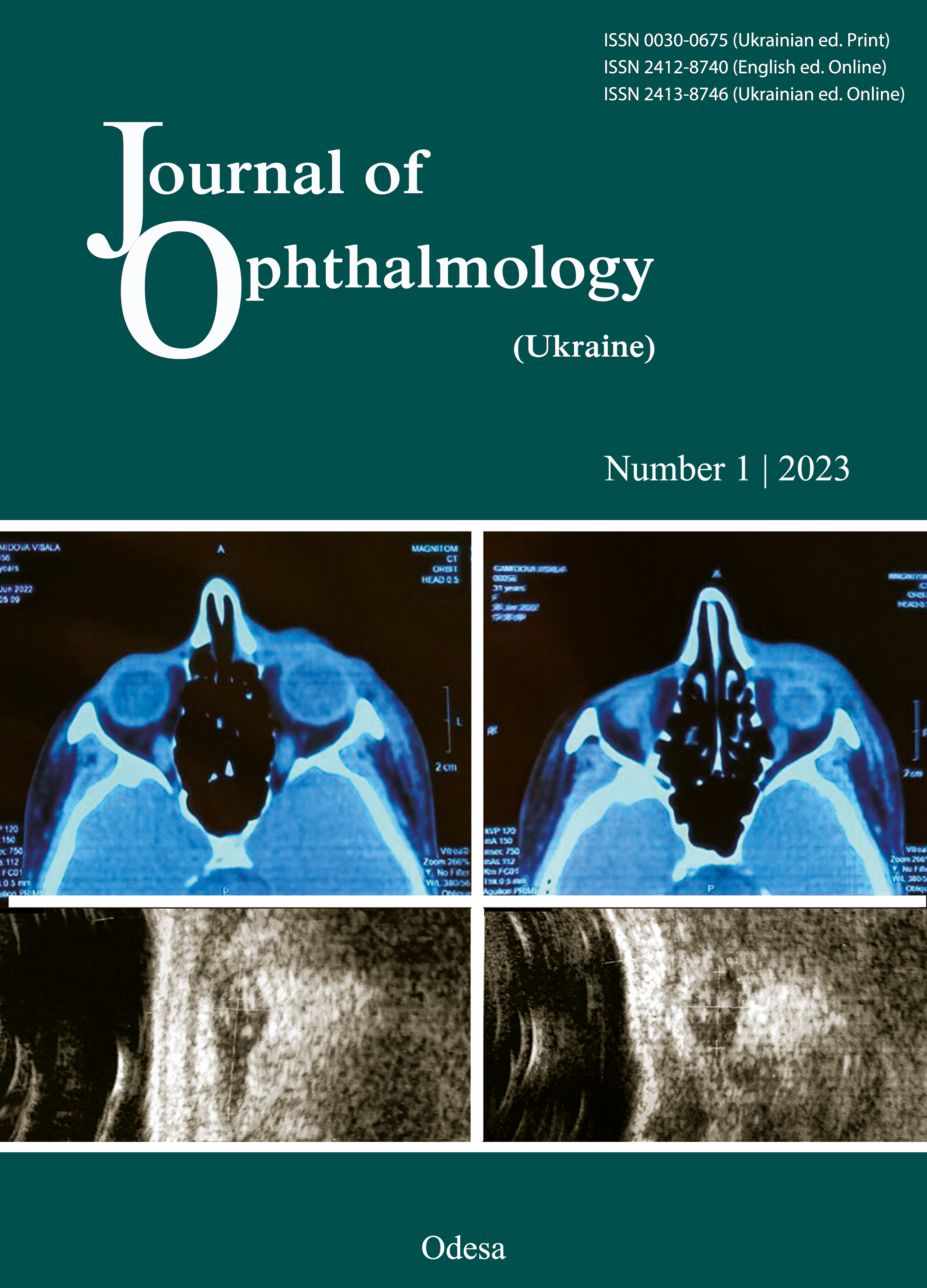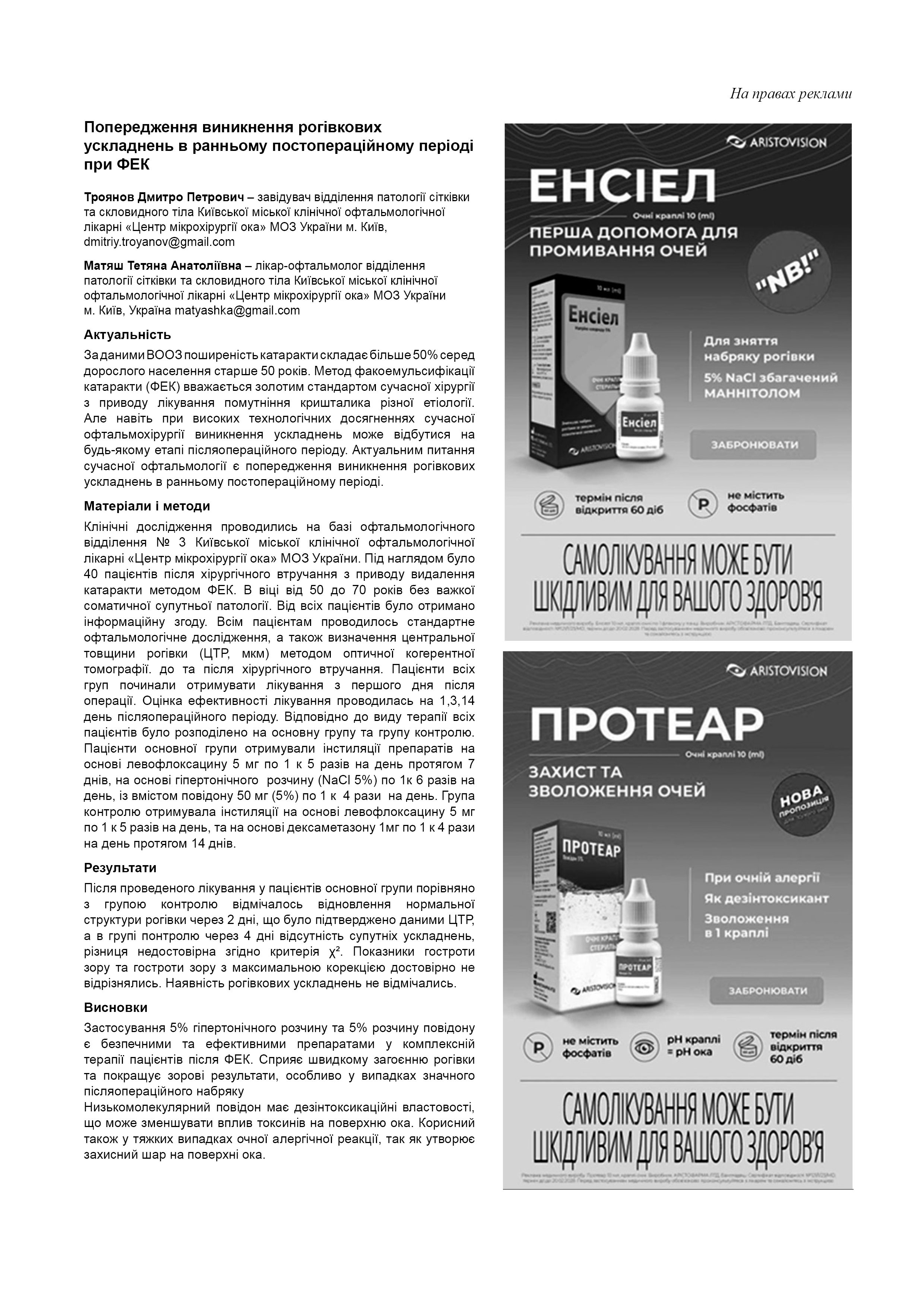Experience of providing eye care to the wounded at the NMMCC “Main Military Clinical Hospital” during the defense of Kyiv in February-April 2022
DOI:
https://doi.org/10.31288/oftalmolzh202316873Keywords:
combat ocular trauma, levels of the support system for treatment , evacuation of casualtiesAbstract
Background: A full-scale Russian invasion of the territory of Ukraine required the military medical authorities to introduce corrections in the operation of the support system for treatment and evacuation of casualties with combat ocular trauma (COT). While the combat activities were taking place in Kyiv’s suburbs, the inpatient eye clinics of the city actively contributed to the provision of care to casualties.
Purpose: To examine the results of the managing decisions made on the introduction of corrections in the operation of the support system for treatment and evacuation of casualties with COT on the basis of the comparative analysis of the efficacy of medical care provided to casualties at the eye clinic of the National Military Medical Clinical Center “Main Military Clinical Hospital” (NMMCC “MMCH”).
Material and Methods: We presented the results of the analysis of (a) changes in the pattern and amount of treatment and diagnostic interventions provided to casualties in different time periods related to changes in the tactical combat situation and (b) transformation in the levels of provision of medical care to casualties with COT that took place due to the above changes. The structure of causes and locations of ocular and ocular adnexal injuries was calculated based on the aggregated data from medical papers related to treatment of combat casualties at the eye clinic of the NMMCC “MMCH” during 2014-2021 and February-April 2022. System, comparative and content analysis methods, descriptive modeling, statistical analysis and principal methods of treatment and diagnosis of eye disease were used as methods of the study.
Results: It was demonstrated that the urgent corrections introduced in the conventional four-level system of medical and evacuation support during combat activities in the metropolitan suburbs of Kyiv were timely and adequate. We reviewed the changes in the pattern of COT in different periods of combat activities on the territory of Ukraine and indentified the issues requiring primary consideration in order to remove the shortcomings in the organizational support of the treatment and evacuation of casualties with COT.
Conclusion: First, the results of our comparative analysis of the advanced support system for treatment and evacuation of casualties under combat actions in aggravated tactical situations (particularly, during the defense of the metropolitan area of Kyiv), demonstrated the efficacy of the algorithms and standards recommended by NATO. Second, the front line advancing to the outskirts of the metropolitan area required making urgent managing decisions on introducing corrections in the classical four-level support system for treatment and evacuation of casualties (particularly, those with COT), which caused the NMMCC “MMCH” to unite and coordinate their care efforts with those of the special medical facilities of the metropolitan area of Kyiv. There were changes in the amount of eye care provided, with a change to level 3 and subsequently in the opposite direction to level 4, within a very short period, which did not cause difficulties for the military medical personnel. Third, combat actions at the outskirts of the metropolitan area of Kyiv resulted in an increase in the percentage of the wounded with combat-related injuries of the eye and adnexa to 9.4% of the total number of wounded, with more than half (54%) of them represented by penetrating injuries, particularly those with an intraocular foreign body (43.3%). The percentage of binocular injuries and eye destruction increased to 29.8% and the percentage of multiple combat-related injuries to 81.4%, likely primarily due to wide use of high-kinetic-energy weapons with high-velocity fragments from explosive munitions of these systems having wide-area effects. Fourth, we found that treatment outcomes were better when casualties with COT (a) had an early single-stage evacuation to the destination point and (b) were timely provided with special care, which is especially important in bilateral severe eye injuries with a threat of irreversible visual function loss. Finally, the identified problems and shortcomings were causeded primarily by impaired logistics of the support of treatment and evacuation of casualties, and shortage of medical staff (particularly, specialty doctors), medications and medical supplies, particularly at the territories which external communications were temporarily blocked.
References
Заруцький ЯЛ, Білий ВЯ, Денисенко ВМ, Асланян АС. Воєнно-польова хірургія: підручник. Київ: Фенікс; 2018. 552 с.
Жупан ББ, Бадюк МІ Офтальмологічна допомога військовослужбовцям сил оборони України в умовах збройних конфліктів: метод. рек. Київ: Чалчинська НВ; 2018. 69 с.
Бадюк М, Жупан Б, Микита О. Оцінка спроможностей системи медичного забезпечення за вимогами стандартів НАТО. Актуальні питання суспільних наук та історії медицини / Current issues of social studies and history of medіcine: Joint Ukrainian-Romanian scientific journal. 2013;2(22):92-88.
Blackford BG, Justin GA, Baker KM, Brooks DI, Wang H-CH, Ryan DS. et al. Proliferative Vitreoretinopathy After Combat Ocular Trauma in Operation Iraqi Freedom and Operation Enduring Freedom: 2001-2011. Ophthalmic Surgery, Lasers and Imaging Retina. 2020;51(10):556-563. https://doi.org/10.3928/23258160-20201005-03
Bryan JS, Justin GA, Reed DS, Jaksha AF, Davies BW. et al. Enucleations and Eviscerations for Combat Ocular Trauma Performed During Operations Iraqi and Enduring Freedom, Journal of Craniofacial Surgery. 2019;30(3):767-770. https://doi.org/10.1097/SCS.0000000000005294
Clinton K, Murray CK, Wilkins K, Molter NC, Li F, Yu L, et al. Infections Complicating the Care of Combat Casualties During Operations Iraqi Freedom and Enduring Freedom. The Journal of Trauma: Injury, Infection, and Critical Care. 2011; 71(1):62-73. https://doi.org/10.1097/TA.0b013e3182218c99
Emergency war surgery. Washington, DC: Borden Institute, 2013. Українське видання. 2022:213-225.
Weichel ED, Colyer MH, Ludlow SE, Bower KS, Eiseman AS. Combat Ocular Trauma Visual Outcomes during Operations Iraqi and Enduring Freedom. Ophthalmology. 2008;115(12):2235-2245. https://doi.org/10.1016/j.ophtha.2008.08.033
Kazmirchuk A, Yarmoliuk Y, Lurin I, Gybalo R, Burianov O, Derkach S, Karpenko K. Ukraine's Experience with Management of Combat Casualties Using NATO's Four-Tier "Changing as Needed" Healthcare System. World J Surg. 2022; 46(12):2858-2862. https://doi.org/10.1007/s00268-022-06718-3
Sia RK, Ryan DS, Brooks DI, Kagemann JM, Bower KS, French LM et al. The Impact of Combat Ocular Trauma and Traumatic Brain Injury on Vision- and Health-Related Quality of Life Among U.S. Military Casualties. Military Medicine. 2021;187:209-215. https://doi.org/10.1093/milmed/usab233
Nguyen QD, Kruger EF, Kim AJ, Lashkari MH, Lashkari K. Combat Eye Trauma: Intraocular Foreign Body Injuries During the Iran-Iraq War (1980-1988). International Ophthalmology Clinics. 2002;42(3):167-177. https://doi.org/10.1097/00004397-200207000-00018
Gensheimer WG, Kerber MT, Blanch RJ. The epidemiology and outcomes of combat ocular trauma among local nationals managed at a deployed military hospital in Afghanistan. Eye. 2021;35(8): 2155-2163. https://doi.org/10.1038/s41433-020-01316-w
Downloads
Published
How to Cite
Issue
Section
License
Copyright (c) 2023 Zhupan B.B., Lurin I.A., Medvedovska N.V., Khramov I.I.

This work is licensed under a Creative Commons Attribution 4.0 International License.
This work is licensed under a Creative Commons Attribution 4.0 International (CC BY 4.0) that allows users to read, download, copy, distribute, print, search, or link to the full texts of the articles, or use them for any other lawful purpose, without asking prior permission from the publisher or the author as long as they cite the source.
COPYRIGHT NOTICE
Authors who publish in this journal agree to the following terms:
- Authors hold copyright immediately after publication of their works and retain publishing rights without any restrictions.
- The copyright commencement date complies the publication date of the issue, where the article is included in.
DEPOSIT POLICY
- Authors are permitted and encouraged to post their work online (e.g., in institutional repositories or on their website) during the editorial process, as it can lead to productive exchanges, as well as earlier and greater citation of published work.
- Authors are able to enter into separate, additional contractual arrangements for the non-exclusive distribution of the journal's published version of the work with an acknowledgement of its initial publication in this journal.
- Post-print (post-refereeing manuscript version) and publisher's PDF-version self-archiving is allowed.
- Archiving the pre-print (pre-refereeing manuscript version) not allowed.



.png)










